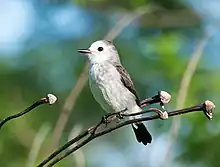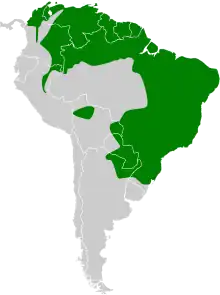White-headed marsh tyrant
The white-headed marsh tyrant (Arundinicola leucocephala), also known as simply the marsh tyrant, is a small passerine bird in the tyrant flycatcher family, the only species of the genus Arundinicola. It breeds in tropical South America from Colombia, Venezuela and Trinidad south to Bolivia, Argentina and Paraguay.
| White-headed marsh tyrant | |
|---|---|
 | |
| Male in São Paulo, Brazil | |
 | |
| Female in São Paulo, Brazil | |
| Scientific classification | |
| Domain: | Eukaryota |
| Kingdom: | Animalia |
| Phylum: | Chordata |
| Clade: | Dinosauria |
| Class: | Aves |
| Order: | Passeriformes |
| Family: | Tyrannidae |
| Genus: | Arundinicola d'Orbigny, 1840 |
| Species: | A. leucocephala |
| Binomial name | |
| Arundinicola leucocephala (Linnaeus, 1764) | |
 | |
| Synonyms | |
| |
Description
The adult white-headed marsh tyrant is 12.7 cm long and weighs 15 g. The male is entirely brown-black, apart from the relatively large white head and yellowish lower mandible. The female has brown upperparts and wings and a black tail. Her underparts, sides of the head and forecrown are dull white. This is a quiet species, but the call is a sharp sedik.
_-Argentina-8.jpg.webp)
This species is found in marshy savannahs, reedbeds and the edges of mangrove swamps.
Diet
White-headed marsh tyrants wait on an exposed low perch in marsh vegetation or a branch near water, occasionally sallying out to feed on insects, their staple diet, before returning to the perch. They often pick off insects from the vegetation, but more frequently out of mid-air and even from shallow water.[2] Insects preyed upon include dragonflies, grasshoppers, froghoppers and beetles.[3]
The nest is a feather-lined oval ball of grasses and other plant material, with a porched side entrance. It is placed at the end of a branch near or over water. Both sexes incubate the typical clutch of two or three creamy-white eggs, which are marked with a few brown spots. Cowbirds often parasitise the nest.
This bird is not considered threatened by the IUCN. Local populations may disappear however due to declining habitat quality.[4]
Footnotes
- BirdLife International (2016). "Arundinicola leucocephala". IUCN Red List of Threatened Species. 2016: e.T22700291A93767511. doi:10.2305/IUCN.UK.2016-3.RLTS.T22700291A93767511.en. Retrieved 12 November 2021.
- de A. Gabriel & Pizo (2005)
- "Arundinicola leucocephala (White-headed Marsh Tyrant)" (PDF). Sta.uwi.edu. Retrieved 29 March 2022.
- Faria (2006), BLI (2008)
References
- de A. Gabriel, Vagner & Pizo, Marco A. (2005): Foraging behavior of tyrant flycatchers (Aves, Tyrannidae) in Brazil. Revista Brasileira de Zoologia 22(4): 1072–1077. doi:10.1590/S0101-81752005000400036 PDF fulltext
- Faria, Christiana M.A.; Rodrigues, Marcos; do Amaral, Frederico Q.; Módena, Érica & Fernandes, Alexandre M. (2006): Aves de um fragmento de Mata Atlântica no alto Rio Doce, Minas Gerais: colonização e extinção [The birds of an Atlantic Forest fragment at upper Rio Doce valley, Minas Gerais, southeastern Brazil: colonization and extinction]. Revista Brasileira de Zoologia 23(4): 1217-1230 [Portuguese with English abstract]. doi:10.1590/S0101-81752006000400032 PDF fulltext
- ffrench, Richard; O'Neill, John Patton & Eckelberry, Don R. (1991): A guide to the birds of Trinidad and Tobago (2nd edition). Comstock Publishing, Ithaca, N.Y.. ISBN 0-8014-9792-2
- Hilty, Steven L. (2003): Birds of Venezuela. Christopher Helm, London. ISBN 0-7136-6418-5
External links
- "White-headed marsh tyrant" videos on the Internet Bird Collection
- "White-headed marsh tyrant" photo gallery VIREO
- Photo-High Res; Article-w/photos
- Photo-High Res; Article geometer–"Brazil Photos"
